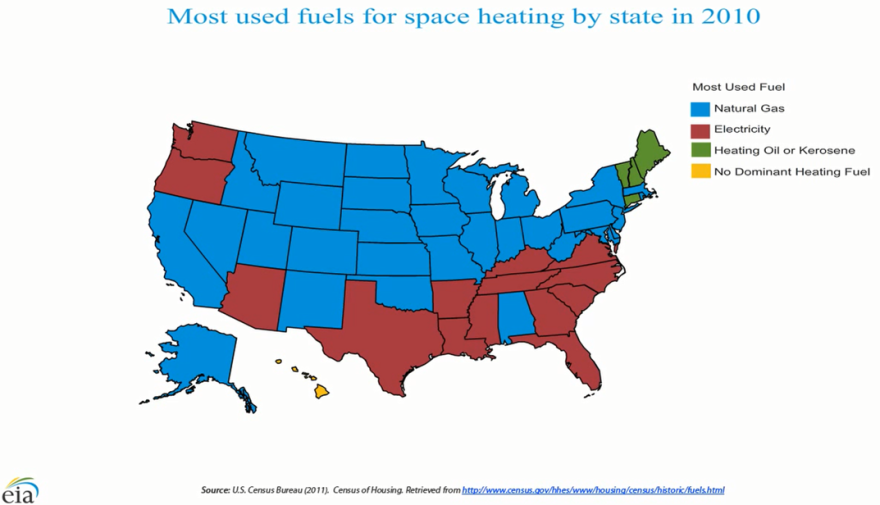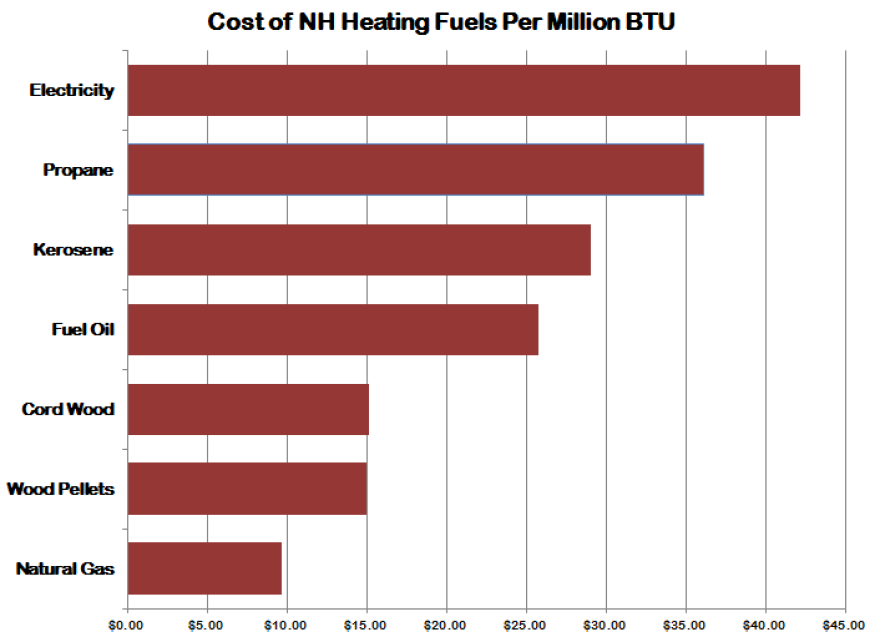The frost advisories are beginning to pile up and boilers in basements are cycling on to take the edge off of the autumn chill: heating season is upon us.
In most homes there’s only one source of heat and options for saving on the one source of fuel are pretty limited, but that’s not to say they don’t exist. And of course there are those times when that 30-year-old boiler refuses to kick on for the last time, or when shifting prices of fuels do make it justifiable to install something new in the utility closet. So here’ s a check in on price trends and the fuel landscape for New Hampshire home heating.
The Heating Oil Outlook
With 47 percent of homes using heating oil, New Hampshire is one of only four states where that fuel dominates. Natural gas leads in most Northern states, and electricity leads in most of the south. The Pacific Northwest is the exception to that rule, since cheap electricity there makes electric heating competitive in a way that it isn’t elsewhere.

As anyone with an oil boiler can tell you, overall trends in heating oil aren’t great: despite a dramatic dip during the economic crash, price per gallon has more than doubled this decade. That said, government projections indicated that this year consumers might get a bit of a reprieve from ever climbing costs. The EIA last week forecast that fuel oil costs would be 5% lower than last year, mostly due to increased production in non-OPEC countries (including domestic production in the Bakken Oil fields in South Dakota). That decrease, if it comes to pass, would continue a 3 year trend of more or less flat prices.
Of course that forecast is far from a sure thing. “If you talk to three different agencies or three different analysts you’ll probably get three different stories,” notes John Rider, Chairman of the Oil Heat Council of New Hampshire. As always, any disruption in big oil producing countries could create a spike in prices.
But with rising steadily prices customers who pre-buy can get some certainty and even savings if they buy early enough. Prices do tend to rise modestly as the winter approaches, and “13 of the last 15 years have proven to be a winner for those who have locked their price in the summer,” says Matt Cota, executive director of the Vermont Fuel Dealers Association. Cota does note that as the price of fuel has risen, fewer buyers are opting to pre-buy, because paying all at once has become too expensive. And if you're hoping to save some cash this year, it's probably too late for a pre-buy: the real savings happen during the price sags of the summer.
Switching to Gas?
The most recent data from the state’s Office of Energy and Planning puts heating with natural gas at 62 percent cheaper than heating with fuel oil. The EIA forecasts that gas prices should top last year's prices by 15 percent as winter advances, but even with that increase gas would remain the cheapest way to stay warm this winter.

But are customers flocking to gas in response? The state’s biggest gas supplier Liberty Utilities says that about 250 homes a year are converting to gas, which is not exactly a break-neck pace. This is in part because much of New Hampshire’s population is rural, and since it’s tough to store natural gas only homes that can hook in to pipelines can switch. There are two main pipelines in the state: one runs from Concord to Nashua, and the second passes through the Seacoast on its way to Maine.
While fuel oil dealers in other areas of New England – like in Western Massachusetts and Bangor, Maine – are feeling pinched by consumers switching to gas, on the Seacoast of New Hampshire “we’re not experiencing any pressure from natural gas,” says Rider. Clearly fuel oil's dominance is assured for some time to come.
Home Grown Fuels
New England is at the tail end of nearly every energy pipeline except for one: wood. That’s why after Natural Gas, wood is the cheapest way to heat your home in terms of dollars per BTU. This is increasingly making wood pellets “a relatively attractive alternative for people who don’t mind a little more labor involved with heating their home,” says Charlie Niebling of consulting firm Innovative Natural Resource Solutions, and former manager of New England Wood Pellet.

But while pellets are said anecdotally to be on the rise, relatively few homes have pellet stoves or boilers. Of course, there’s always good old cordwood, though (again) now is not really the time to buy it. The ideal moment for that would have been this spring, says Eric Johnson of the New Hampshire Timberland owners association, “right after road bans come off” in May or June and loggers can get to work. Wood purchased green and dried in the back yard can save upwards of $80 per cord. Consumers late to the party can still pay a premium for already seasoned logs, or even kiln dried wood, and even if the price tops $250 a cord you're still paying less for heat than burning fuel oil. And that doesn't even count the free heat you'll generate while chopping and stacking.
8.5 percent of homes in New Hampshire list wood as their primary heat source, and there are plenty of wood-burning boosters in the state who believe that number can be much higher. Those who preach wood are working hard to convince more homes to install automatic pellet boilers instead of fossil fuel fired ones. Their argument is that wood is a fuel that will grow back on the scale of decades, not millennia, and buying it means shipping fewer energy dollars out of the state.
That Other Gas
Professor at Franklin Pierce University Michael Mooiman points out that the state uses more propane than any other New England state, and is only surpassed by Vermont in propane use per capita. Nearly 14 percent of homes heat with propane in New Hampshire compared to 5 percent in the country. New Hampshire and New England burn way more propane than the rest of the country.
Why is propane use so high in New Hampshire? Because it’s mostly rural, people need a fuel that can be easily transported and stored, which is why natural gas is not as dominant here as it is in much of the rest of the country. A number of factors have likely driven customers to propane – high fuel oil costs and aggressive salesmen who have pitched propane as a “clean”, domestically produced fuel are two notable ones – but once they’ve made the switch Mooiman notes that many are now “somewhat stuck”, since the upfront cost of switching back is so high.
Propane can be confusing for some consumers because per gallon it is cheaper than heating oil, but because it contains less energy per gallon. OEP data puts propane at 40 percent more expensive than oil for space heating. Propane is a byproduct of oil and gas production, and prices tend to track the price of oil fairly closely. So the price story here is similar: a bit of a plateau over the last two years, but an overall trend toward higher prices.
Efficiency: Always a Bridesmaid
There are huge savings to be had by adding insulation to attics and sealing homes against cold air that leaks in during the winter months, but it can be difficult to coax home-owners into efficiency investments. Even with subsidies paying as much as half the cost of improvements, occasionally New Hampshire Utilities have had to send back unused energy efficiency dollars because so few homeowners in the state take part in the programs.
Companies that do weatherization say that they can consistently reduce energy bills by 30 percent, and that these improvements can often pay back in under a decade, or even in a few years for some improvements. So while switching fuels or shopping carefully for fuels might be on the forefront of many people’s minds this time of year, using less is the surest way to save.
Note: An earlier version of this article referred to Franklin Pierce University as Franklin Pierce College, this has been corrected.



